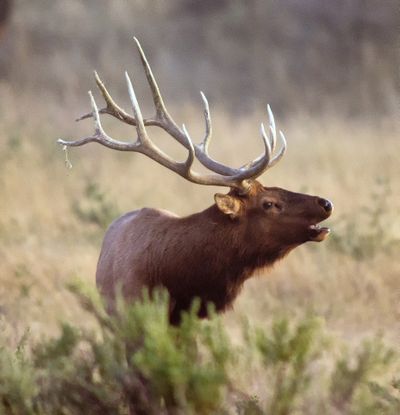Wolf impact on elk keeps heat on wildlife managers

Idaho elk hunters have had to adapt to a “new normal” that looks a lot different from boom years of the 1990s, when the harvests topped 25,000 three times, in 1991, ’94 and ’96.
Those were record harvests dating back to 1935.
Not coincidentally, the number of Idaho elk hunters also peaked in 1995 at 101,500 hunters.
Those peak seasons roughly coincided with the reintroduction of wolves in 1995-96, and the two species have been intertwined ever since.
Idaho’s golden years of elk hunting were from 1988 to 1996, when elk harvests never dipped below 20,000 animals.
Since then, they’ve topped 20,000 just twice — in 2005 and 2006.
Many hunters have blamed wolves for the crash in elk populations in some areas. Surely they were a factor, but the predators can’t take all the blame.
In 1996, the last year the elk harvest topped 25,000, Idaho had about 42 wolves, according to Fish and Game statistics.
By 1999, the elk harvest dropped to 17,500, a 30 percent decrease. And Idaho’s wolf population that year? About 156 wolves, according to Fish and Game statistics.
It’s a stretch to correlate a 30 percent reduction in elk harvest to a statewide increasae of 114 wolves over three years.
But since then, wolf populations exploded and elk harvests, along with hunter numbers, trended downward.
Elk hunting seems to have bottomed out in 2011, when hunters had the smallest elk harvest in 30 years, and there’s been a modest rebound.
But like all things involved with managing and hunting elk, it’s complicated, and the data often become more a point of argument than enlightenment.
For example, elk hunter success rates improved from 2009-12 while the statewide harvest declined.
Fewer hunters took fewer elk, but on a percentage basis, more hunters were successful.
By contrast, the statewide elk harvest bottomed out in 2011 at 15,155 and increased to 16,418 in 2012, then held steady in 2013 at 16,437.
But Fish and Game sold 5,500 more elk tags in 2013. So while the harvest held steady, the success rate dropped, but was still a respectable 21 percent overall.
Why did hunters buy 5,500 more elk tags? Fish and Game’s state wildlife manager Jon Rachael credits the bump to hunters seeing more elk.
This year’s harvest may continue that, and there may be a modest increase in the harvest, which, however slight, would still be three straight years of increased elk harvest.
Out of Idaho’s 29 elk zones, Fish and Game reports 20 are meeting or exceeding the department’s population objectives for cows and bulls. Eight are under objectives, and one zone splits with some areas under and some areas meeting objectives.
Fish and Game said game managers are seeing improved calf numbers in some zones that have recently been depressed, such as the Sawtooth Zone.
Hunters have reacted by buying up the quota of tags for that zone.
“That’s very encouraging,” Rachael said.